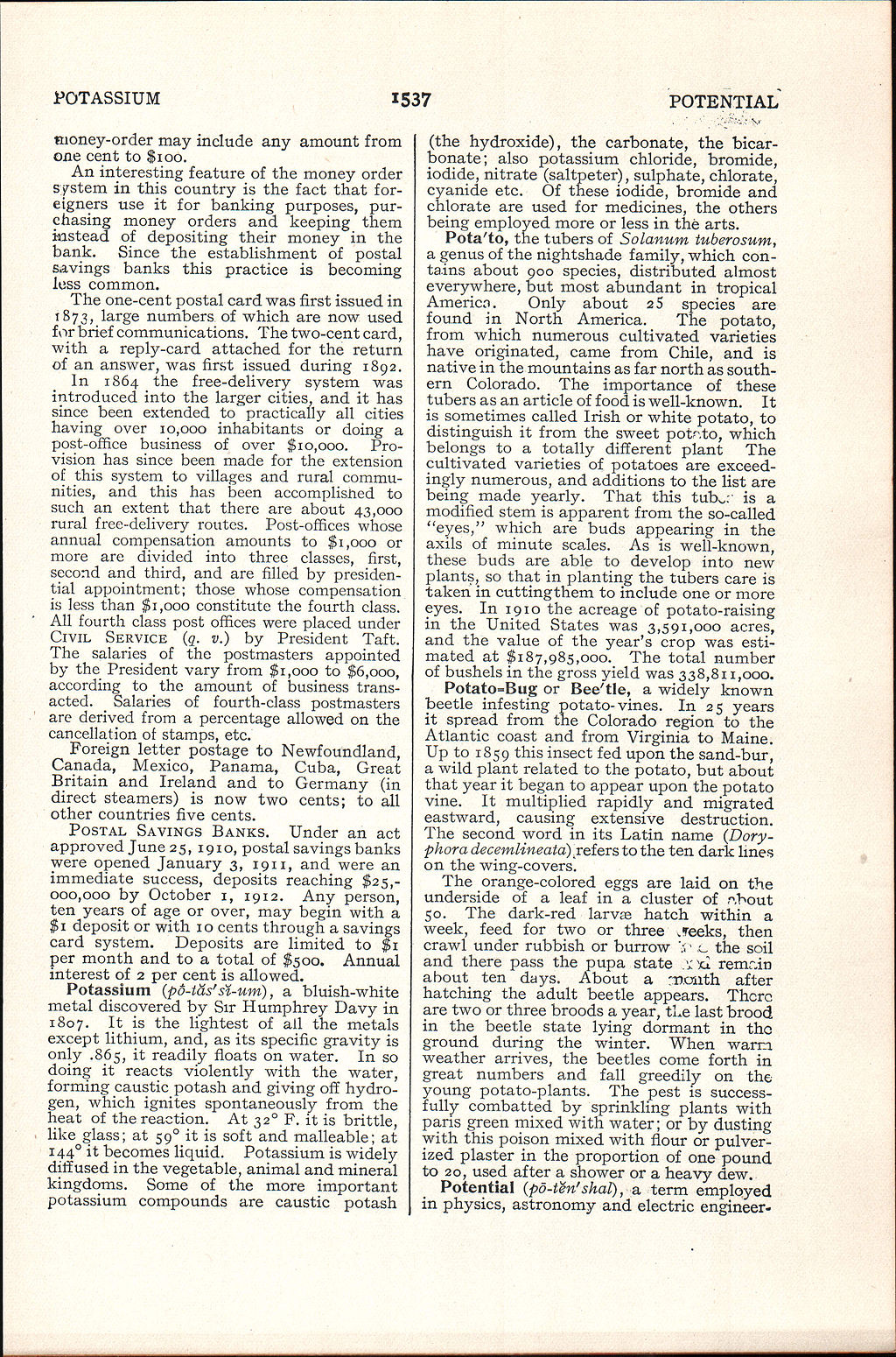money-order may include any amount from one cent to $100.
An interesting feature of the money order system in this country is the fact that foreigners use it for banking purposes, purchasing money orders and keeping them instead of depositing their money in the bank. Since the establishment of postal savings banks this practice is becoming less common.
The one-cent postal card was first issued in 1873, large numbers of which are now used for brief communications. The two-cent card, with a reply-card attached for the return of an answer, was first issued during 1892.
In 1864 the free-delivery system was introduced into the larger cities, and it has since been extended to practically all cities having over 10,000 inhabitants or doing a post-office business of over $10,000. Provision has since been made for the extension of this system to villages and rural communities, and this has been accomplished to such an extent that there are about 43,000 rural free-delivery routes. Post-offices whose annual compensation amounts to $1,000 or more are divided into three classes, first, second and third, and are filled by presidential appointment; those whose compensation is less than $1,000 constitute the fourth class. All fourth class post offices were placed under Civil Service (q. v.) by President Taft. The salaries of the postmasters appointed by the President vary from $1,000 to $6,000, according to the amount of business transacted. Salaries of fourth-class postmasters are derived from a percentage allowed on the cancellation of stamps, etc.
Foreign letter postage to Newfoundland, Canada, Mexico, Panama, Cuba, Great Britain and Ireland and to Germany (in direct steamers) is now two cents; to all other countries five cents.
Postal Savings Banks. Under an act approved June 25, 1910, postal savings banks were opened January 3, 1911, and were an immediate success, deposits reaching $25,000,000 by October 1, 1912. Any person, ten years of age or over, may begin with a $1 deposit or with 10 cents through a savings card system. Deposits are limited to $1 per month and to a total of $500. Annual interest of 2 per cent is allowed.
Potassium (pō̇-tăs′sĭ-um), a bluish-white metal discovered by Sir Humphrey Davy in 1807. It is the lightest of all the metals except lithium, and, as its specific gravity is only .865, it readily floats on water. In so doing it reacts violently with the water, forming caustic potash and giving off hydrogen, which ignites spontaneously from the heat of the reaction. At 32° F. it is brittle, like glass; at 59° it is soft and malleable; at 144° it becomes liquid. Potassium is widely diffused in the vegetable, animal and mineral kingdoms. Some of the more important potassium compounds are caustic potash (the hydroxide), the carbonate, the bicarbonate; also potassium chloride, bromide, iodide, nitrate (saltpeter), sulphate, chlorate, cyanide etc. Of these iodide, bromide and chlorate are used for medicines, the others being employed more or less in the arts.
Pota′to, the tubers of Solanum tuberosum, a genus of the nightshade family, which contains about 900 species, distributed almost everywhere, but most abundant in tropical America. Only about 25 species are found in North America. The potato, from which numerous cultivated varieties have originated, came from Chile, and is native in the mountains as far north as southern Colorado. The importance of these tubers as an article of food is well-known. It is sometimes called Irish or white potato, to distinguish it from the sweet potato, which belongs to a totally different plant. The cultivated varieties of potatoes are exceedingly numerous, and additions to the list are being made yearly. That this tuber is a modified stem is apparent from the so-called “eyes,” which are buds appearing in the axils of minute scales. As is well-known, these buds are able to develop into new plants, so that in planting the tubers care is taken in cutting them to include one or more eyes. In 1910 the acreage of potato-raising in the United States was 3,591,000 acres, and the value of the year's crop was estimated at $187,985,000. The total number of bushels in the gross yield was 338,811,000.
Potato-Bug or Bee′tle, a widely known beetle infesting potato-vines. In 25 years it spread from the Colorado region to the Atlantic coast and from Virginia to Maine. Up to 1859 this insect fed upon the sand-bur, a wild plant related to the potato, but about that year it began to appear upon the potato vine. It multiplied rapidly and migrated eastward, causing extensive destruction. The second word in its Latin name (Doryphora decemlineata) refers to the ten dark lines on the wing-covers.
The orange-colored eggs are laid on the underside of a leaf in a cluster of about 50. The dark-red larvæ hatch within a week, feed for two or three weeks, then crawl under rubbish or burrow into the soil and there pass the pupa state and remain about ten days. About a month after hatching the adult beetle appears. There are two or three broods a year, the last brood in the beetle state lying dormant in the ground during the winter. When warm weather arrives, the beetles come forth in great numbers and fall greedily on the young potato-plants. The pest is successfully combatted by sprinkling plants with paris green mixed with water; or by dusting with this poison mixed with flour or pulverized plaster in the proportion of one pound to 20, used after a shower or a heavy dew.
Potential (pō-tĕn′shal), a term employed in physics, astronomy and electric engineer-
